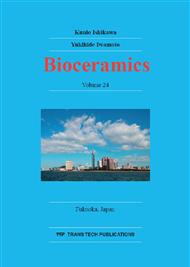[1]
J. Ugelstad, P. Stenstad, L. Kilaas, W.S. Prestvik, R. Herje, A. Bererge, E. Hornes, Monodisperse magnetic polymer particles, Blood Purif. 11 (1993) 349-369.
DOI: 10.1159/000170129
Google Scholar
[2]
A. Elaïssari, R. Veyret, B. Mandrand, J. Chatterjee, Surfactant Science Series 116: Colloidal Biomolecules, Biomaterials, and Biomedical Applications, in A. Elaissari (Ed. ) Marcel Dekker, New York, 2004, pp.1-26.
DOI: 10.1201/9780203912843.ch1
Google Scholar
[3]
M. Kuhara, H. Takeyama, T. Tanaka, T. Matsunaga, Magnetic cell separation using antibody binding with protein A expressed on bacterial magnetic particles, Anal. Chem. 76 (2004) 6207-6213.
DOI: 10.1021/ac0493727
Google Scholar
[4]
Y. Namba, M. Usami, O. Suzuki, Highly sensitive electrochemiluminescence immunoassay using the ruthenium chelate-labeled antibody bound on the magnetic micro beads, Anal. Sci. 15 (1999) 1087-1093.
DOI: 10.2116/analsci.15.1087
Google Scholar
[5]
A. Elässari, M. Rodrigue, F. Meunier, C. Herve, Hydrophilic magnetic latex for nucleic acid extraction, purification and concentration, J. Magn. Magn. Mater. 225 (2001) 127-133.
DOI: 10.1016/s0304-8853(00)01240-3
Google Scholar
[6]
J. Oster, J. Parker, L. À Brassard, Polyvinyl-alcohol-based magnetic beads for rapid and efficient separation of specific or unspecific nucleic acid sequences, J. Magn. Magn. Mater. 225 (2001) 145-150.
DOI: 10.1016/s0304-8853(00)01243-9
Google Scholar
[7]
S. Akgöl, Y. Kaçar, A. Denizli, M.Y. Arca, Hydrolysis of sucrose by invertase immobilized onto novel magnetic polyvinylalcohol microspheres, Food Chem. 74 (2001) 281-288.
DOI: 10.1016/s0308-8146(01)00150-9
Google Scholar
[8]
F.Y. Cheng, C.H. Su, Y.S. Yang, C.S. Yeh, C.Y. Tsai, C.L. Wu, M.T. Wu, D.B. Shieh, Characterization of aqueous dispersions of Fe3O4 nanoparticles and their biomedical applications, Biomaterials 26 (2005) 729-738.
DOI: 10.1016/j.biomaterials.2004.03.016
Google Scholar
[9]
J. Chatterjee, M. Bettge, Y. Haik, C. Jen Chen, Synthesis and characterization of polymer encapsulated Cu-Ni magnetic nanoparticles for hyperthermia applications, J. Magn. Magn. Mater. 293 (2005) 303-309.
DOI: 10.1016/j.jmmm.2005.02.024
Google Scholar
[10]
J. Ugelstad, A. Berge, T. Ellingsen, R. Schmid, T. -N. Nilsen, P.C. Mork, P. Sienstad, E. Hornes, Ø. Olsvik, Preparation and application of new monosized polymer particles, Prog. Polym. Sci. 17 (1992) 87-161.
DOI: 10.1016/0079-6700(92)90017-s
Google Scholar
[11]
F. Caruso, M. Spasova, A. Susha, M. Giersig, R.A. Caruso, Magnetic nanocomposite particles and hollow spheres constructed by a sequential layering approach, Chem. Mater. 13 (2001) 109-116.
DOI: 10.1021/cm001164h
Google Scholar
[12]
E. Sada, S. Katoh, M. Terashima, Performance of an enzyme reactor utilizing a magnetic field, Biotechnol. Bioeng. 22 (1980) 243-246.
DOI: 10.1002/bit.260220120
Google Scholar
[13]
A. Kondo, H. Kamura, K. Higashitahi, Development and application of thermo-sensitive magnetic immunomicrospheres for antibody purification, Appl. Microbiol. Biotechnol. 41 (1994) 99-105.
DOI: 10.1007/bf00166089
Google Scholar
[14]
S. Lu, J. Forcada, Preparation and characterization of magnetic polymeric composite particles by miniemulsion polymerization, J. Polym. Sci., Part A: Polym. Chem. 44 (2006) 4187–4203.
DOI: 10.1002/pola.21525
Google Scholar
[15]
D. Horak, Magnetic polyglycidylmethacrylate microspheres by dispersion polymerization, J. Polym. Sci., Part A: Polym. Chem. 39 (2001) 3707-3715.
DOI: 10.1002/pola.10000
Google Scholar
[16]
R.J. Mumper, U.Y. Ryo, M. Jay, Neutron activated holmium-166-Poly(L-lactic acid) microspheres: A potential agent for the internal radiation therapy of hepatic tumours, J. Nucl. Med. 32 (1991) 2139-2143.
Google Scholar
[17]
B. Arechabala, C. Coiffard, P. Rivalland, L.J.M. Coiffard, Y. De Roeck-Holtzhauer, Comparison of cytotoxicity of various surfactants tested on normal human fibroblast cultures using the neutral red test, MTT assay and LDH release, J. Appl. Toxicol. 19 (1999).
DOI: 10.1002/(sici)1099-1263(199905/06)19:3<163::aid-jat561>3.0.co;2-h
Google Scholar
[18]
P. -C. Wang, W. -Y. Chiu, C. -F. Lee, T. -H. Young, Synthesis of iron oxide/poly(methyl methacrylate) composite latex particles: Nucleation mechanism and morphology, J. Polym. Sci. Part A: Polym. Chem. 42 (2004) 5695-5705.
DOI: 10.1002/pola.20335
Google Scholar
[19]
S. Lu, J. Ramos, J. Forcada, Self-stabilized magnetic polymeric composite nanoparticles by emulsifier-free miniemulsion polymerization, Langmuir 23 (2007) 12893-12900.
DOI: 10.1021/la702281k
Google Scholar
[20]
S. Beyaz, T. Tanrisever, H. Kockar, V. Butun, Superparamagnetic latex synthesized by a new route of emulsifier-free emulsion polymerization, J. Appl. Polym. Sci. 121 (2011) 2264-2272.
DOI: 10.1002/app.33895
Google Scholar
[21]
S. Fujii, M. Okada, T. Furuzono, Hydroxyapatite nanoparticles as stimulus-responsive particulate emulsifiers and building block for porous materials, J. Colloid Int. Sci. 315 (2007) 287-296.
DOI: 10.1016/j.jcis.2007.06.071
Google Scholar
[22]
S. Fujii, M. Okada, H. Sawa, T. Furuzono, Y. Nakamura, Hydroxyapatite nanoparticles as particulate emulsifier: Fabrication of hydroxyapatite-coated biodegradable microspheres, Langmuir 25 (2009) 9759-9766.
DOI: 10.1021/la901100z
Google Scholar
[23]
H. Maeda, M. Okada, S. Fujii, Y. Nakamura, T. Furuzono, Pickering-type water-in-oil-in-water multiple emulsions toward multihollow nanocomposite microspheres. Langmuir 26 (2010) 13727-13731.
DOI: 10.1021/la102529d
Google Scholar
[24]
M. Okada, H. Maeda, S. Fujii, Y. Nakamura, T. Furuzono, Formation of pickering emulsions stabilized via interaction between nanoparticles dispersed in aqueous phase and polymer end groups dissolved in oil phase, Langmuir 28 (2012) 9405-9412.
DOI: 10.1021/la3015964
Google Scholar
[25]
Y. Miwa, S. Fukumoto, H. Koyama, M. Okada, S. Tanaka, T. Shoji, M. Emoto, T. Furuzono, Y. Nishizawa, M. Inaba, Enhancement of cell-therapeutic angiogenesis using a novel type of jnjectable scaffolds of hydroxyapatite-polymer nanocomposite microsheres, PLoS ONE 7 (2012).
DOI: 10.1371/journal.pone.0035199
Google Scholar
[26]
X. Liu, M. Okada, H. Maeda, S. Fujii, T. Furuzono, Hydroxyapatite/biodegradable poly(L-lactide-co-e-caprolactone) composite microparticles as injectable scaffolds by a Pickering emulsion route, Acta Biomater. 7 (2011) 821-828.
DOI: 10.1016/j.actbio.2010.08.023
Google Scholar


